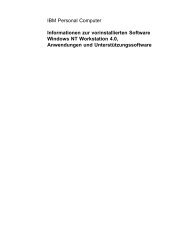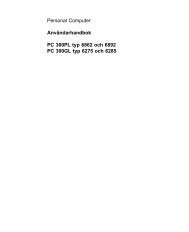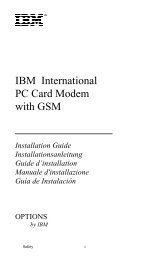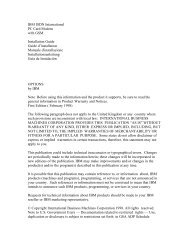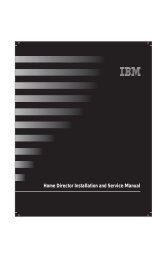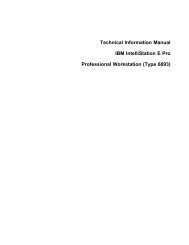IntelliStation E Pro User Guide Professional ... - FTP Directory Listing
IntelliStation E Pro User Guide Professional ... - FTP Directory Listing
IntelliStation E Pro User Guide Professional ... - FTP Directory Listing
You also want an ePaper? Increase the reach of your titles
YUMPU automatically turns print PDFs into web optimized ePapers that Google loves.
Starting Your Computer<br />
Before you begin<br />
Please observe the following:<br />
� When the power cord is first plugged in, the computer appears to power on<br />
for a few seconds, and then power off. This is a normal sequence to enable<br />
the computer to self initialize.<br />
� What you see and hear when you start up your computer depends upon<br />
settings in the Configuration/Setup Utility program. See “Settings that<br />
Affect the Startup <strong>Pro</strong>cedure” on page 16 for more information.<br />
� If you plan to start your computer over a network, see “Starting Your<br />
Computer Over a Network” on page 17.<br />
To start your computer<br />
1. Turn on all devices connected to the computer.<br />
2. Press and release the power switch on your computer. If you have changed<br />
settings for features (such as passwords or the startup sequence) in the<br />
Configuration/Setup Utility program, see “Settings that Affect the Startup<br />
<strong>Pro</strong>cedure” on page 16 for important information.<br />
If you have not changed any settings in the Configuration/Setup Utility<br />
program, the following actions occur:<br />
� The video BIOS is installed.<br />
� The IBM logo appears on the screen.<br />
� The power-on self-test (POST) is performed. If POST detects a problem, you<br />
hear multiple beeps (or no beep) and an error message appears on the<br />
screen. Write down any error code numbers and descriptions.<br />
� The computer allows you to enter the Configuration/Setup Utility program<br />
(by pressing F1) or run a fast POST (by pressing Esc).<br />
� If you have a SCSI model, the SCSI BIOS is installed.<br />
3. A DHCP (Dynamic Host Configuration <strong>Pro</strong>tocol) request is sent to the network,<br />
and one of the following events occurs:<br />
� If you are properly connected to a network, a DHCP server dynamically<br />
assigns an IP (internet protocol) address to your computer and then loads a<br />
startup image onto your computer.<br />
� If the DHCP request is unsuccessful, the following message appears:<br />
Chapter 4. Operating Your Computer 13




